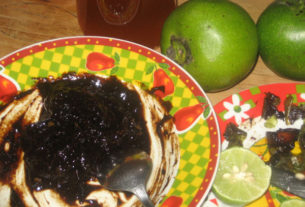Salitre is the Spanish term commonly used for masonry “efflorescence.” Salitre is the white powdery stain that forms on the surface of bricks and concrete and can cause the stucco or paint on a wall or tiles on the floor to lift off. It is a common issue for many homes here at Lake Chapala that are made of bricks, mortar and concrete (masonry elements), which irritates some homeowners while others simply tolerate and maintain it. In extreme cases the cause of salitre can lead to structural problems since the water has effectively washed out the key chemicals that provide the strength in the mortar or bricks themselves or cause oxidation of the reinforcing steel however, in these rare cases the water exposure has been excessive and/or over a long period of time. Typically, the efflorescence problem is more cosmetic rather than destructive.
To understand the problem of efflorescence, lets discuss the science of what is happening. Water in the masonry element (mortar, brick or concrete) dissolves the salts (dissolvable minerals) present in the mixture and transports them to the surface where the water is evaporated and the salts are left behind. Two key elements need to be present for the efflorescence to appear: dissolvable calcium salts and water.
The salts in bricks, mortar and concrete are present in varying degrees however, these salts are more common in construction in Mexico since albañiles (bricklayers) like to use “ cal” (Lime: Calcium Oxide), which works as a plasticiizer to increase the workability of the mortar and the ultimate hardness of the mortar. The “Cal” does provide some benefits for the bricklayer and the final product, however this is the primary source of salts that cause efflorescence.
The second element that causes efflorescence is water. The water can be from many sources including leaking pipes, garden over spray but primarily is from ground water and rainwater. Small leaks in the roof will infiltrate the roof structure to ultimately cause the efflorescence on the interior ceiling. Moisture from below grade will be drawn up from below by capillary action commonly called “wicking.” The wicking action is supported by the evaporation at the surface of the wall or floor.
It sounds simple — all we have to eliminate is the water and/or the amount of salts in the masonry materials and we have solved our salitre problems. It is difficult to eliminate all the salts available in the all the masonry materials, therefore the problem is to address the source of water. However, this can be difficult, of course, since all of our homes are exposed to the natural environment, which includes rain, and our homes are built on the ground where moisture naturally occurs. So care needs to be taken to determine the correct location and source of water that is causing the efflorescence to minimize and hopefully eliminate this root cause of the problem.
Some sources of water have been leaks in the roof, however investigation should be done to identify the correct source, which could be multiple. On inclined roofs the efflorescence stain may occur downhill from the source of the leak on the roof and not directly above the stain. Salitre on walls may be caused by rain on the exposed exterior of the wall or from a leak on the roof or parapet that finds a route to percolate down the wall to a point where it can escape and evaporate. However, the water may be wicking up the wall from a source below the floor such as a leaking pipe or aljibe, or simply the floor slab has direct contact with the soil below. Various solutions to minimize or eliminate the water source include metal flashing, waterproofing the surface with a impermeable paint material or simple providing adequate drainage to keep the water away and prevent it from contacting the masonry material.
Whenever cleaning an efflorescence stain, a mild acid solution should be used. First wash the affected area with water and then scrub the area with the mild acid solution. A final washing with water will help neutralize any latent acid that is still on the masonry surface. Allow the area to dry and wait before painting to assure that the efflorescence does not return. It is also recommended to paint an alkyd primer to better adhere to the surface and resist peeling off again.


Thanks for the great post on salitre – it’s a topic that’s close to my heart! I’m currently dealing with this issue in my home.
There is a good video on youtube about how to treat it. I live in La Penita, MX and I used muriatic acid, followed by rinsing, then an anti-salitre treatment (same viscosity as water) 3 consecutive days, then white stucco-ed the whole area (easy to do) and rolled it with white primer from Comex. Looks a lot better.